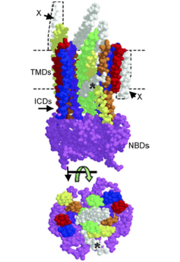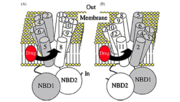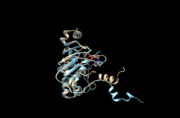Sandbox effluxpumps
From Proteopedia
|
Efflux pumps function to move different substances out of cells such as ions, lipids, and molecules that are toxic for the cell. [1] ATP-binding cassette (ABC) transporters are a common class of efflux pumps found in all forms of life. Humans have forty-eight known ABC transporters. An example of an ABC transporter is ABCB6.
Contents |
Structural Highlights

One unit of an ATP-binding cassette consists of a nucleotide binding domain and a trans-membrane domain that has six α-helices. Hydrophilic loops and the nucleotide-binding domain separate the α-helices. [1] Two nucleotide-binding domains are responsible for binding to and hydrolyzing ATP. The two transmembrane domains of a functional ABC transporter are used to form the chamber that substrates use to move across the membrane. [2] It is important to note that in ABC transporters the Walker A and B motifs are conserved and have a role in hydrogen bonding to and hydrolyzing ATP, an ABC transporter signature motif. The different motifs in ABC transporters form the ATP binding site. [1]
Function

An ATP-switch model for transport has been used to describe ABC transporters. For transport, a switch between two conformations of the nucleotide binding domain dimer serves as the promoter. The binding of ATP induces the rotation of domains within the nucleotide-binding domain. A closed dimer with two molecules of ATP between the dimer is formed. [2]The hydrolysis of ATP into ADP and Pi returns the dimer to an open configuration. The binding of ATP to the nucleotide binding domains and the closed dimer formation induces conformational changes in the transmembrane domains that aid in the movement of substrate out of the cell. The transmembrane domain is shifted so that the domain is visible to the extracellular face of the membrane and the substrates can then be released. Similar to the nucleotide-binding domain, the hydrolysis of ATP to ADP and Pi restores the dimer to its beginning conformation. [2]
Energetics

There are two theories for the power stroke for ABC transporters. One model states that the formation of a “nucleotide sandwich” dimer results in changes in conformation that are relayed to the drug binding site, followed by two ATP hydrolysis events that changes the molecule to its starting conformation.[3] Another model also requires two ATP hydrolysis events, one hydrolysis event is used to drive the efflux of the drug and another hydrolysis event is used to bring the protein back to its beginning conformation.[3] Both models follow an “alternating catalytic sites” scheme in which only one of the nucleotide-binding domains hydrolyzes ATP and the two nucleotide-binding domains alternate during the catalytic cycles. [3] The energy of ATP hydrolysis is necessary to bring the protein back to its initial state.
ABCB6
ABCB6 is an ABC transport protein that is located in the outer mitochondrial membrane. This transporter is involved in multi-drug resistance and antigen presentation and is required for porphyrin uptake. [4] ABCB6 is 11kb long and contains 19 exons in its protein-coding region. [5] ABCB6 is a transmembrane protein with 11 transmembrane helices arranged in two membrane-spanning domains and a nucleotide-binding domain, which is located on the cytosolic side of the membrane. ABCB6 dimerizes to form a functional unit of four membrane-spanning domains and two nucleotide binding sites. [6] The widely conserved Walker A and Walker B motifs are part of the nucleotide-binding site architecture. These motifs are the basis of ATP specificity. [6] Changes in the overall structure upon nucleotide binding and differences in the structure when ATP is bound versus when ADP is bound indicates that ATP hydrolysis is coupled with intramolecular movements. The conformational changes in the structure are necessary for the transport process that allows substrates to move across the membrane. [6]
References
- ↑ 1.0 1.1 1.2 1.3 1.4 M. Hennessy and J.P. Spiers, “A Primer on the Mechanics of P-glycoprotein the Multidrug Transporter,” Pharmacological Research 55 (2007): 1.
- ↑ 2.0 2.1 2.2 Christopher F. Higgins, “Multiple Molecular Mechanisms for Multidrug Resistance Transporters,” Nature 446 (2007): 750.
- ↑ 3.0 3.1 3.2 3.3 Suresh V. Ambudkar, In-Wha Kim, and Zuben E. Sauna “The Power of the Pump: Mechanisms of Action of P-glycoprotein (ABCB1),” Science Direct 27 (2006): 393.
- ↑ Krishnamurthy, P. C., Du, G., Fukuda, Y., Sun, D., Sampath, J., Mercer, K. E., Wang, J., Sosa-Pineda, B., Murti, K. G., Schuetz, J. D. Identification of a mammalian mitochondrial porphyrin transporter. Nature 443: 586-589, 2006.
- ↑ Mitsuhashi, N., Miki, T., Senbongi, H., Yokoi, N., Yano, H., Miyazaki, M., Nakajima, N., Iwanaga, T., Yokoyama, Y., Shibata, T., Seino, S. MTABC3, a novel mitochondrial ATP-binding cassette protein involved in iron homeostasis. J. Biol. Chem. 275: 17536-17540, 2000.
- ↑ 6.0 6.1 6.2 Haffke, Matthias, Anja Menzel, Yvonne Carius, Dieter Jahn, and Dirk W. Heinz. "Structures of the Nucleotide-binding Domain of the Human ABCB6 Transporter and Its Complexes with Nucleotides." Acta Crystallogr D Biol Cryst Acta Cryst D Acta Crystallogr Sect D Biol Crystallogr Acta Crystallogr Sect D Acta Crystallogr D Biol Crystallogr Acta Crystallographica Section D Biological Crystallography Acta Cryst Sect D Acta Crystallogr D 66.9 (2010): 979-87. Web.

